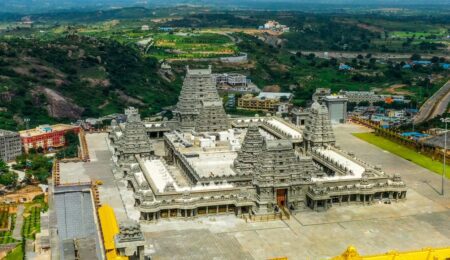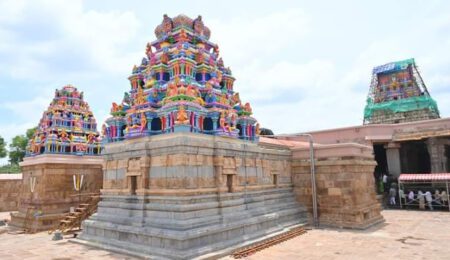The Great Living Chola Temples
Introduction of Chola Temples
Chola Temples : In the fertile plains of Tamil Nadu, where the sacred Kaveri River nourishes centuries of civilization, stand the Great Living Chola Temples monuments that transcend time. These temples, recognized as UNESCO World Heritage Sites, are not just architectural marvels but living embodiments of South India’s spiritual and cultural heritage.
Built during the zenith of the Chola dynasty (9th–13th century CE), these temples Brihadisvara Temple in Thanjavur, Gangaikonda Cholapuram, and Airavatesvara Temple in Darasuram represent the pinnacle of Dravidian architecture. Their towering vimanas, exquisite sculptures, and enduring rituals continue to inspire awe, devotion, and scholarly admiration.
But the Chola legacy extends far beyond these three. A constellation of associated temples each with its own story, style, and sanctity dot the Tamil landscape, forming a sacred network that shaped the region’s religious and cultural identity.
Historical Context: The Rise and Glory of the Chola Dynasty
The Cholas were among the most powerful and visionary rulers in South Indian history. Emerging from the heart of the Kaveri delta, they transformed Tamil Nadu into a cultural and imperial powerhouse.
- Rajaraja Chola I and Rajendra Chola I spearheaded a golden age of temple construction, maritime expansion, and artistic patronage.
- Temples were not just places of worship they were centers of administration, economic activity, and cultural production.
- The Cholas pioneered bronze casting, granite architecture, and epigraphic documentation, leaving behind a legacy that shaped South Indian temple traditions for centuries.
Their temples were built to last not just physically, but spiritually. Even today, these structures remain active centers of Shaivism, hosting daily rituals, annual festivals, and vibrant community life.
Temples of the Chola Dynasty
Brihadisvara Temple, Thanjavur
Commissioned by Rajaraja Chola I in 1010 CE, Brihadisvara Temple is the crown jewel of Chola architecture.
- Vimana: Towering at 66 meters, it’s one of the tallest temple towers in India.
- Nandi: A massive monolithic bull statue guards the sanctum.
- Inscriptions: Over 600 inscriptions detail temple administration, donations, and rituals.
- Significance: A UNESCO World Heritage Site, it exemplifies Chola engineering, devotion, and imperial pride.
Gangaikonda Cholapuram
Built by Rajendra Chola I to commemorate his northern conquests, this temple mirrors Brihadisvara in grandeur but adds its own elegance.
- Architecture: Graceful vimana with curved contours and refined sculptures.
- Sacred Tank: Filled with water brought from the Ganges, symbolizing spiritual unity.
- Bronze Icons: Exceptional examples of Chola artistry.
- Legacy: A statement of power, piety, and pan-Indian vision.
Airavatesvara Temple, Darasuram
Constructed by Rajaraja Chola II in the 12th century, this temple is a masterpiece of sculptural finesse.
- Musical Steps: Stone steps that produce different notes when tapped.
- Mandapa: Designed like a chariot with wheels and horses.
- Carvings: Intricate depictions of deities, dancers, and mythological scenes.
- UNESCO Status: Celebrated for its artistic innovation and architectural brilliance.
Vijayala-Cholesvaram
Built by Vijayalaya Chola in the 9th century, this temple marks the beginning of Chola temple architecture.
- Style: Early Chola with Pallava influences.
- Features: Modest scale, yet historically significant as the dynasty’s first temple.
- Importance: A symbol of Chola resurgence and religious patronage.
Ayikudi Balasubramanya Swami Temple
Located in Tenkasi district, this temple is dedicated to Lord Murugan as a child.
- Deity: Balasubramanya, revered for granting boons and protection.
- Cultural Role: A vibrant center for Murugan worship, deeply rooted in Tamil devotional traditions.
- Festivals: Skanda Sashti and Panguni Uthiram are celebrated with fervor.
Nageswaraswamy Temple
Situated in Kumbakonam, this temple was built by Aditya Chola I.
- Architecture: Classic Chola vimana and mandapa layout.
- Iconography: Rich Shaivite sculptures and inscriptions.
- Festivals: Mahashivaratri and temple car festivals draw thousands of devotees.
Moovar Koil
Located in Kodumbalur, this temple complex was built by a Chola feudatory, Rajaraja Sambuvaraya.
- Structure: Three shrines dedicated to Shiva, Vishnu, and Brahma.
- Design: Rare example of triadic temple planning.
- Significance: Reflects the diversity and inclusivity of Chola religious architecture.
Koranganatha Temple
Found in Srinivasanallur, this temple showcases early Chola craftsmanship.
- Layout: Compact Dravidian design with square sanctum and vimana.
- Sculptures: Depictions of Shiva as Nataraja, Dakshinamurti, and guardian deities.
- Importance: A gem of early Chola architecture, blending simplicity with sanctity.
Valisvara Temple
Located in Thiruvalisvaram, Tirunelveli, this temple was built by Raja Raja Chola I.
- Deity: Shiva in sukhasana pose, a rare representation.
- Sculptures: Ardhanarishvara and other unique forms.
- Style: Blend of Chola and Pandya architectural elements.
- Role: A hidden treasure in Chola temple heritage, protected by the ASI.
Kampaheswarar Temple
Situated in Thirubuvanam, this temple was built by Kulothunga Chola III.
- Mythology: Shiva cured a king’s trembling (kampa) caused by a Brahmarakshasa.
- Deity: Sarabeswarar, a fierce form of Shiva.
- Architecture: Tall vimana, sculptural panels, and metal icons.
- Legacy: Considered the last great Chola temple, marking the end of an era.
Architectural Brilliance
The Chola temples are masterpieces of Dravidian architecture, characterized by:
- Vimanas: Towering pyramidal structures above the sanctum.
- Mandapas: Pillared halls for rituals and gatherings.
- Gopurams: Ornate gateway towers, often added in later periods.
- Sculptures: Depictions of deities, dancers, and mythical beings in granite and bronze.
Chola Bronze Icons
- Technique: Lost-wax casting (cire perdue).
- Nataraja: Shiva’s cosmic dance symbolizes creation and destruction.
- Legacy: Over 3,000 bronze icons were crafted during the Chola period, many of which are now in museums worldwide.
Stone Inscriptions
- Languages: Tamil and Grantha script.
- Content: Temple donations, rituals, royal decrees, and community contracts.
- Importance: Vital records for historians and epigraphists.
Religious and Cultural Importance of Chola Temples
The Chola temples are not just historical monuments they are living centers of faith and culture.
- Shaivism: The Cholas were ardent Shaivites, and their temples remain active places of worship.
- Festivals: Mahashivaratri, Thiruvathirai, and Pradosham are celebrated with grandeur.
- Cultural Legacy: Patronage of Nayanmar saints, Tamil hymns, Bharatanatyam, and temple music.
Their influence extends beyond Tamil Nadu, shaping temple traditions across South India and Southeast Asia.
Travel and Visitor Guide
| Temple | Nearest Airport | Nearest Railway Station | Entry Fee | Visiting Hours | Best Time to Visit |
|---|---|---|---|---|---|
| Brihadisvara, Thanjavur | Tiruchirapalli (TRZ) | Thanjavur | Free | 6 AM – 8 PM | Oct–Mar |
| Gangaikonda Cholapuram | Trichy | Kumbakonam | Free | 6 AM – 8 PM | Oct–Mar |
| Airavatesvara, Darasuram | Trichy | Kumbakonam | Free | 6 AM – 8 PM | Nov–Feb |
| Valisvara Temple | Tuticorin | Ambasamudram | Free | Variable | Nov–Feb |
| Kampaheswarar Temple | Trichy | Kumbakonam | Free | 6 AM – 8 PM | Dec–Feb |
Travel Tips
- Hire local guides for epigraphic insights.
- Carry socks or temple-friendly footwear for hot stone floors.
- Combine temple visits with nearby attractions like Chidambaram, Mahabalipuram, and Pudukottai.
Conservation and UNESCO Preservation
The Archaeological Survey of India (ASI), in collaboration with UNESCO and Tamil Nadu’s heritage departments, has undertaken extensive conservation efforts to preserve the Great Living Chola Temples and their associated sites. These initiatives aim to safeguard both the physical structures and the intangible cultural heritage they embody.
Key Preservation Measures
- Structural Restoration: Using traditional materials and techniques to repair weathered stonework and stabilize foundations.
- Digital Documentation: High-resolution scans of inscriptions, sculptures, and architectural layouts for archival and research purposes.
- Visitor Management: Controlled access to sensitive zones, improved signage, and guided tours to reduce wear and tear.
- Community Engagement: Involving local communities in temple upkeep, festivals, and heritage education to ensure sustainable preservation.
UNESCO’s recognition has elevated global awareness, drawing scholars, pilgrims, and tourists alike. These temples are now part of a broader conversation about cultural continuity, sacred geography, and the role of living heritage in modern India.
Frequently Asked Questions (FAQs)
Which is the largest Chola temple?
The Brihadisvara Temple in Thanjavur is the largest and most iconic Chola temple, with a vimana that rises over 66 meters and a sprawling temple complex.
What makes the Great Living Chola Temples unique?
They are still active places of worship, built entirely of granite, and feature some of the finest examples of Dravidian architecture, bronze sculpture, and epigraphic records.
Are these temples still functional?
Yes. Daily rituals, annual festivals, and community gatherings continue to be held, preserving their spiritual vitality.
Can tourists visit all these temples?
Absolutely. Most temples are open to the public with no entry fee. However, photography may be restricted in sanctum areas, and respectful attire is recommended.
What is the best time to visit Chola temples in Tamil Nadu?
October to March offers pleasant weather and coincides with many temple festivals, making it ideal for heritage travel.
Are guides available at these sites?
Yes. Certified guides are available at major temples like Thanjavur and Darasuram. For smaller temples, local priests and heritage volunteers often share insights.
Do these temples have any connection to Southeast Asia?
Yes. The Cholas had maritime links with Sri Lanka, Indonesia, and Cambodia, and their temple architecture influenced structures like Angkor Wat and Borobudur.
Conclusion: Why These Temples Are Must-Visit Heritage Sites
The Great Living Chola Temples and their associated shrines are not just remnants of a glorious past they are vibrant, breathing sanctuaries of art, devotion, and identity. They represent the confluence of imperial ambition and spiritual humility, where granite meets grace and history meets the divine.
Whether you’re a history enthusiast tracing dynastic legacies, a spiritual seeker drawn to sacred vibrations, or a traveler in search of timeless beauty, these temples offer an experience that transcends tourism. They invite you to walk barefoot on ancient stone, listen to the echo of chants under towering vimanas, and witness the living rhythm of Tamil Nadu’s soul.
So when you plan your next journey, let it be more than a destination let it be a pilgrimage into the heart of India’s cultural heritage. The Chola temples await, majestic and eternal.
Recommended External URLs
1. Great Living Chola Temples – UNESCO
2. Great Living Chola Temples – Wikipedia




Leave a Comment